The Intel Core i3-7350K (60W) Review: Almost a Core i7-2600K
by Ian Cutress on February 3, 2017 8:00 AM ESTGrand Theft Auto V
The highly anticipated iteration of the Grand Theft Auto franchise finally hit the shelves on April 14th 2015, with both AMD and NVIDIA in tow to help optimize the title. GTA doesn’t provide graphical presets, but opens up the options to users and extends the boundaries by pushing even the hardest systems to the limit using Rockstar’s Advanced Game Engine. Whether the user is flying high in the mountains with long draw distances or dealing with assorted trash in the city, when cranked up to maximum it creates stunning visuals but hard work for both the CPU and the GPU.
For our test we have scripted a version of the in-game benchmark, relying only on the final part which combines a flight scene along with an in-city drive-by followed by a tanker explosion. For low end systems we test at 720p on the lowest settings, whereas mid and high end graphics play at 1080p with very high settings across the board. We record both the average frame rate and the percentage of frames under 60 FPS (16.6ms).
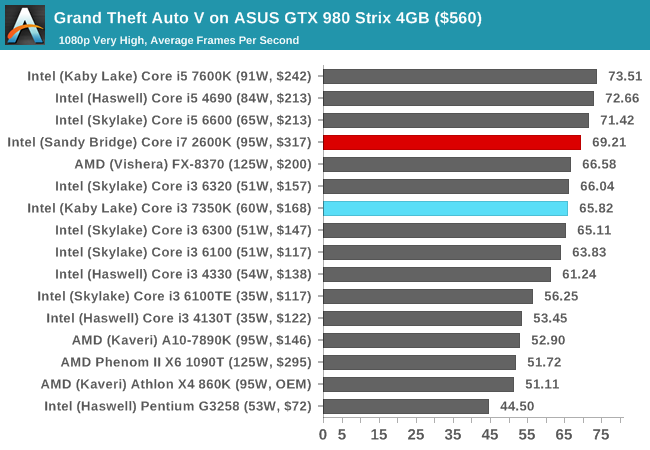
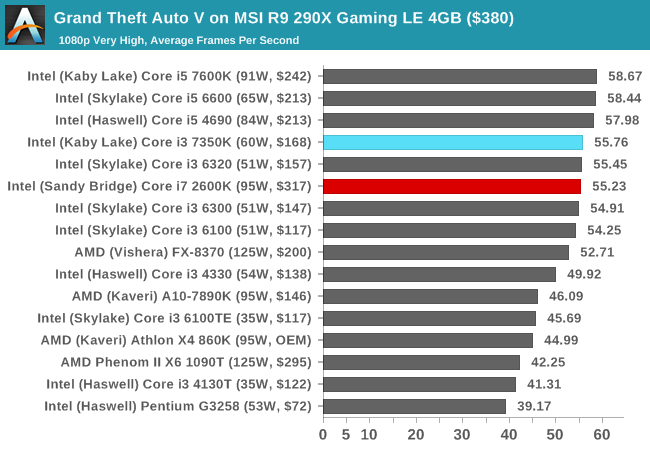
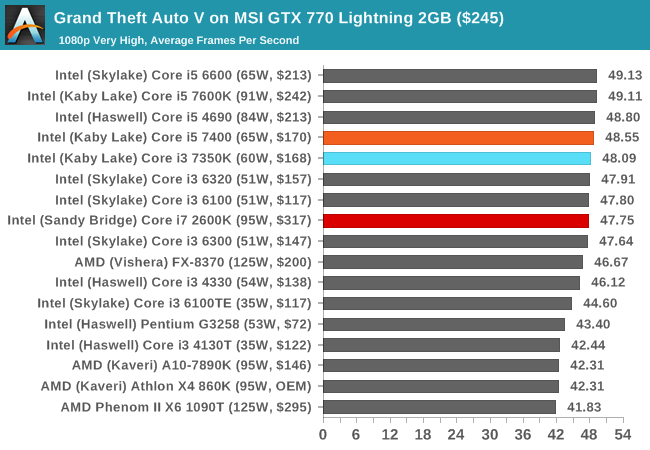

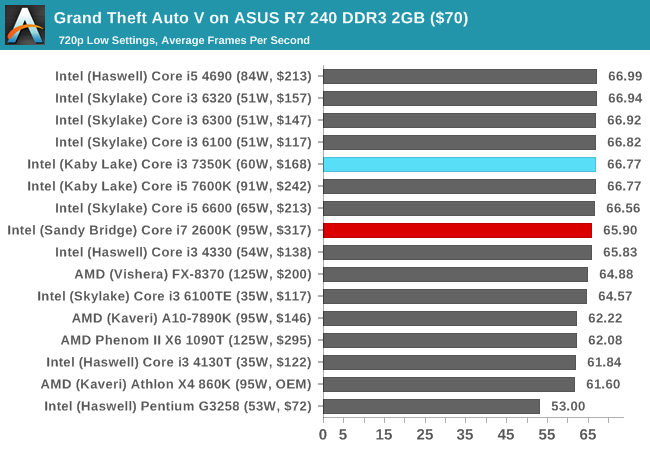
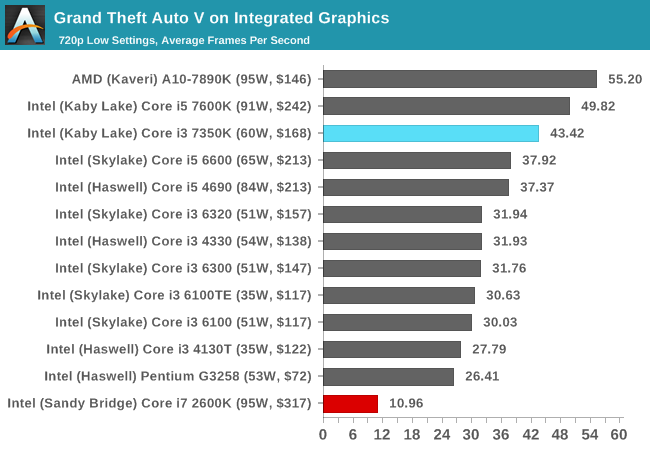
The older Core i7-2600K eeks out a small ~5 FPS advantage over the Core i3 when running a GTX 980 at 1080p maximum settings, but with all other GPUs the differences are minimal. With integrated graphics, the Core i3 shows it can pummel the older IGP into the ground.











186 Comments
View All Comments
forgot2yield28 - Sunday, February 5, 2017 - link
Agreed, the timing of the first ever i3 K variant just ahead of Ryzen seems more than just coincidental. Intel seems to be arguing that for value minded users, the IPC and high clocks will make this a better prospect that Ryzen's many-core and likely somewhat lower IPC. That's not new, what is new is that little K on the end meant to capture that market segment of users on a budget who still want the fun of overclocking. Before, the logic was always that intel wouldn't release an i3 K because it would canabalize i5 sales. Now they seem to be proactively guarding a piece of market share that would pick an overclockabe Ryzen chip instead of an i5. Competition is a wonderful thing!futurepastnow - Sunday, February 12, 2017 - link
"I'd say they are preemptively stacking the product deck prior to the release of AMD Ryzen"Yep, Ryzen will also launch with its high-end parts first- AMD's competitiveness will not filter down to low-end parts until 2h16. Until 2C4T Ryzen parts appear, Intel will still have a monopoly on good cheap processors so the more they can sell in that time, the better, for them.
futurepastnow - Sunday, February 12, 2017 - link
I meant 2h17 lol, I write the date a dozen times a day and still get it wrong.zeeBomb - Friday, February 3, 2017 - link
Hmm. What should I get instead of this then around the price range or cheaper?CaedenV - Friday, February 3, 2017 - link
how about a non-k i3?I mean look at the charts, they keep up just fine. Sure, you don't get overclocking capability, but you also get to save money by not needing a custom cooler ($30-50), or a z-series motherboard ($30-150), and the chips themselves are cheaper ($30-50). That saves you some $90+ on your build right there, while offering most of the performance. Either pocket the money, or spend it on a good SSD or better GPU.
stardude82 - Friday, February 3, 2017 - link
G4560... $64. Widely available now. Preforms just below a i3-6100/i5-2500 above Haswell i3s.Alexvrb - Friday, February 3, 2017 - link
If you want to go cheaper, see CaedenV's post below. If you're thinking about staying in roughly the same price range, get an entry-level i5. Something like a i5-7400. The cost of the processor itself is higher, but the total platform price will be around the same because of cost-savings elsewhere, like Caeden listed for the i3 non-K. You won't need to worry about overclocking so no need for upgraded cooling, and no need for an overclock-friendly board.CaedenV - Friday, February 3, 2017 - link
The i3 available back in the day suffered from quite a few things at the time, and had rather dramatic setbacks compared to the i5 and i7 offerings of the day. Still not bad as an entry level gaming CPU... but even it would bottleneck a mid to high range GPU at the time.But today's i3 offerings are able to offer enough performance to keep up with even today's mid to high end GPUs without problem! Part of that is the move to PCIe3, part of it is efficiency making up for a lack of cores, and part of it is simply because more and more games support HT cores where that use to not be the case.
On a win10 system there is even more advantage as it is better at off-loading background processes to less used cores, so even if your game does not take advantage of HT, windows will in order to alleviate the heavily loaded 'real' cores.
I think the really amazing thing to look at in these charts are how well the non-K i3 chips do. You can save a lot of money if you can give up OC and ~2-300 MHz. a plain-jane i3 on a B or H series chipset and a single mid to high-end GPU would game fantastically compared to a high-end i7 with z-series chip. Still not amazing for content creation (though not bad for a hobbiest)... but if all you are doing is video games, office/school work, web browsing, and watching videos then it is getting harder and harder to recommend anything other than an i3.
cocochanel - Friday, February 3, 2017 - link
I don't understand most comments. If you're gaming, an extra 50$ for an i5 is nothing. A CPU is good enough for 3-4 years. How much are you going to spend on games in that time period ? Here in Canada, Battlefield 1 Premium costs about 160$. That's just one game. How many games are you going to buy ? More than a few I guess. Besides, with DX12 and Vulkan becoming mainstream API's, a quad core is must. Just get an i5 or Ryzen and forget about it.javier_machuk - Friday, February 3, 2017 - link
Am I the only one that thinks that these test should have been between the overclocked speeds of both processors? Isn't the idea behind an unlocked processor that you overclock it?